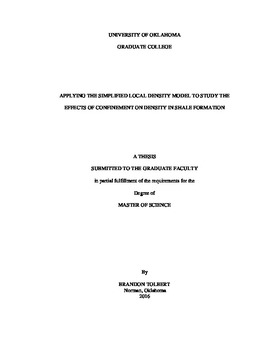| dc.description.abstract | The pores in shale gas reservoirs are represented on a nanometer scale. In addition to having smaller pore sizes than conventional reservoirs, shale gas reservoirs exhibit different mechanisms of gas storage, i.e. gas stored as adsorbed gas. In a confined environment the physics of fluid transport do not conform to Darcy flow. Current and ongoing research efforts have documented that more appropriate physical models are needed to describe flow in nanopourous media. In particular, predicting the density of fluid within a shale environment becomes a critical factor to model flow. Density is a basic transport property that influences the rate at which momentum, heat, and matter is transferred. Understanding density is important because it influences basic fluid transport. Making more accurate density predictions inside nanopores is imperative to predict transport more precisely. Further, density is instrumental in determining the gas storage capacity, transport of fluids, reserve estimation, and long term production forecasting and planning of shale reservoirs.
Prediction of density in shale formations is a complicated issue and the simplified density model (SLD) coupled with an equation of state has provided considerable insight into how density changes in a nanoscale environment. Our approach applies the cylindrical form of the SLD-Peng Robinson EOS model to study the effects of confinement on density in a shale gas formation. In particular, our study provides meaningful insight of gas behavior on a nanoscopic, molecular, and macroscopic level. At the nanoscopic level we examined the density distribution of a multicomponent mixture and observed its dependence on properties such as pressure, temperature, and pore size. At the molecular level we studied the interactions between the fluid molecules and porous wall inside nanopores by analyzing compositional distributions of multicomponent gas mixtures within the pore space. Currently, compositional distributions cannot be routinely observed or measured by laboratory experiments due to physical constraints. At the macroscopic level, we examined the significance of pore size distributions on density by considering identical pore volumes with the aid of the gamma probability density function.
The conclusions derived from this work are as follows:
• Density in shale formations is influenced by pore size due to the fluid-wall interactions and the resulting Van der Waal forces.
• The presence of micropores in shales is associated with more gas in place when pore volumes are identical because the density in smaller pores is larger.
• In a confined environment, the adsorbed phase density is influenced by pore size, temperature, and pressure.
• The overall size of an organic molecule has a significant effect on its adsorption potential. Larger molecules have a tendency to occupy the majority of the pore space along the pore wall.
• Pore size distribution has a tremendous impact on average density in a shale formation and neglecting pore size distribution was shown to yield more than a 69% error for average absorbed phase density estimates. | en_US |
